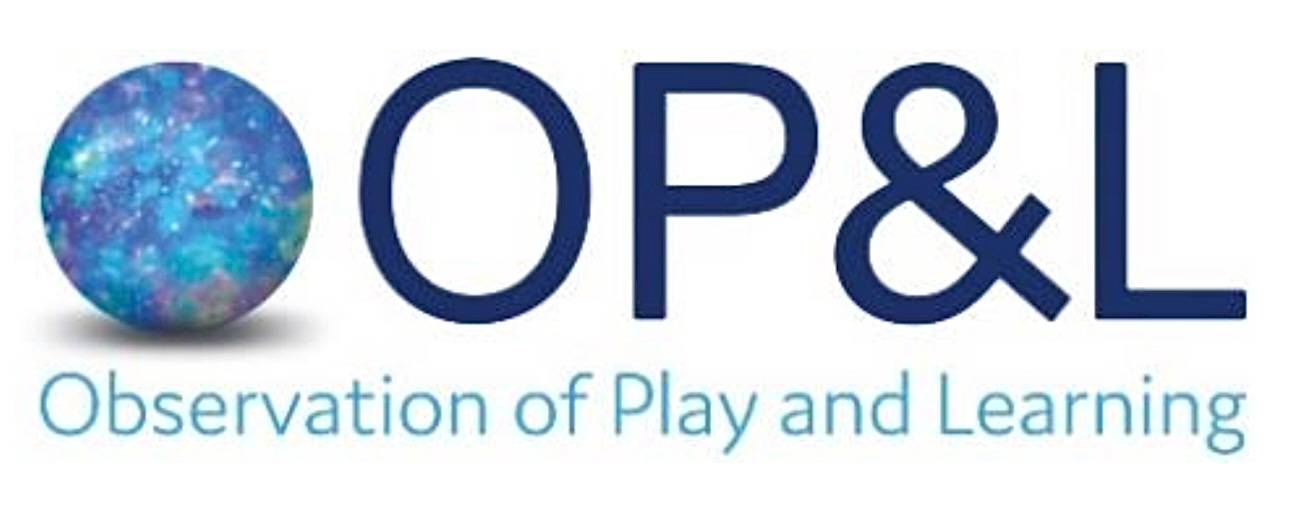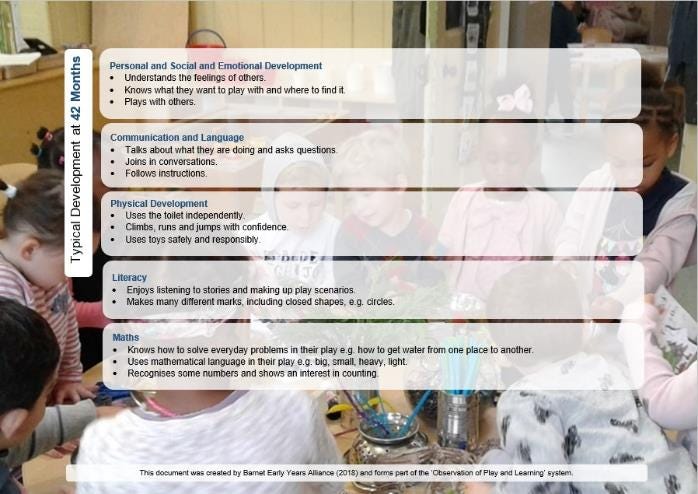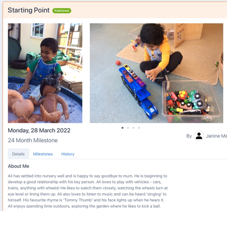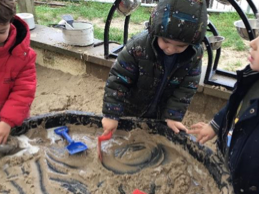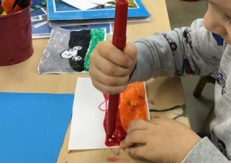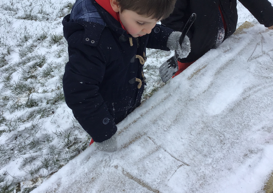So how does OP&L look in practice?
Milestones.
Milestones
OP&L works on the basis of having very simple, six-monthly child developmental milestones, which we use to monitor children’s development. These milestones reflect what we believe a ‘typical’ child, should be able to achieve. When looking at the statements, we assess if the child has met the milestones and record a simple ‘yes’ or ‘not yet’. We know that not all children will have ‘typical’ development. OP&L allows us to tell and celebrate each child’s story and focus on the support they need from us.
Starting points
Not long after a child joins us, we complete a ‘Starting Points’ assessment, looking at the milestones the child has just passed. For example if a child joins us at 39 months, we would look at the milestones for 36 months. This helps us to quickly identify children who are not reaching milestones and may need more support.
Spotlights
The observations and assessments that we make are called ‘spotlights’. We observe children’s innovation, their creativity, their ideas, their intents and feelings. The insight that we gain enables us to discuss, reflect and plan our environment to support and shape future learning. We don’t want to plan a next step to tick a statement off a list. We want to plan learning that will be meaningful and memorable for that child.
As children reach their milestones at different points in the year ‘spotlights’ are spread out, making it fairer for the child as they are being assessed against the age-related milestones that they have reached, not a best fit judgement in a wide age-band. This also reduces paperwork, making it manageable for our practitioners. No termly assessments of all children at the same time!
We follow a simple, three step cycle.
Using Edward as an example, born in May, he would have a starting point when he joins us and then a ‘spotlight’ in November and May. At BEYA, the staff would meet with a member of the leadership team individually at the end of the month. The practitioner would share their knowledge of the child and together think about ways to extend and support their learning, providing new possibilities, opportunities and experiences. This was a wonderful opportunity for staff to share their expertise. (The staff have now become so empowered that they no longer need the support of the leadership team when writing spotlights.)
Previously, we talked about Edward’s love of the outdoors, that he loves water play and being with his best friend, elbow deep in messy play, exploring cause and effect yet tends to avoid mark making. Sitting Edward down with a pencil and trying to get him to use a tripod grip would have been miserable for everyone involved. Early Years practitioners are amongst the most creative thinkers there are! Our knowledge of Edward enabled us to give him the tools and resources that value his interests, enabling him to practice and develop skills to move his learning forward.
We want to shift the focus to the child, not the assessment. The assessment is a quick look at whether a child is meeting their age related milestones and if not, having discussions, thinking about why and planning what to do. When children are meeting milestones, we can think about their individual development holistically, thinking about what we can do to inspire and challenge them further.
Working with parents
Children’s learning is closely monitored in close collaboration with parents to ensure that all children are supported to reach significant milestones for their age.
Take Anthony, he took a very long time to settle in and is non-verbal whilst at nursery, yet talks freely to mum as soon as he leaves the building. Spending time with him has shown us how skilled he is at drawing, his incredible attention to detail and knowledge of cars. Mum was able to share videos of Anthony talking at home, giving us an insight into Anthony’s communication and language development. We have been able to use drawing as a tool for communication, to develop relationships, to build trust and have seen his confidence grow.
Review
We review a ‘spotlight’ 2-3 months later as the final part of the cycle. At this time, we reflect on the child’s progress so far and what we have achieved. Have the learning opportunities and experiences planned taken place? Have they had a positive impact? This again gives us the opportunity to think, to review, to tell the child’s story.
To update you on Edward, we were delighted to see his interest in mark-making did develop. This filled us with joy and told us that our observations, thinking, planning and teaching had supported Edward in his learning.
Assessment of our own practice is key
As an assessment system, OP&L works. But what is really important and runs alongside it, is the assessment that we make of our own practice.
What we are trying to do is ensure is that our schools are ‘places of possibility’. Places in which children and childhood are valued.
The structures that we have in place mean that we have lots of opportunities to talk about children, to think about children, to reflect.
At the end of each day we get together as a staff team with the simple objective to ‘talk about today, talk about tomorrow.’ This allows us to draw out and reflect upon any key observations or information from the day and use it to adapt what we need to do for tomorrow.
Reflective approaches
Over time, we have learnt about and embedded into our practice some really useful approaches that help us think deeply about children’s learning and our teaching. We use these in our weekly staff meetings to help us to see through the eyes of the child. The three approaches that we use are:
Tavistock Observations
Based on a style of observation pioneered at the Tavistock Clinic to train psychotherapists. We carry out a 30 minute observation without taking any notes or photos.
Videos
We use short 5-10 minute video footage of the children at play to discuss as a staff team. Having the time to watch children’s interactions, play and learning without distraction is a real luxury and very useful! We discuss the footage in general and often have a particular focus each term e.g., interactions, use of the environment, well-being, mathematical thinking.
Progression in Play
A member of the team will bring a sequence of photos from a child’s play for us to look at and discuss together. The photos generate questions and help us to think about what we can learn from children’s play and why it is important.
We know that we are very lucky to work in a place that values childhood so venerably and we appreciate the time we have together to reflect. It enables us to develop our professionalism as we continue to learn from the children and from each other.
To access our free resources, please get in touch at opal@beya.org.uk.
You can find more articles from OP&L in our ‘Articles’ or click the buttons below for:



